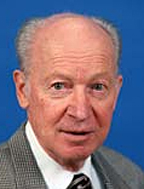- Number 310 |
- April 26, 2010
Mastery of rare-earth elements vital to America's security

Karl Gschneidner, Jr.
Rare-earth elements are critical components in the great majority of America’s high-tech commercial and military products. Scientists combine rare earths with other elements to create alloys intended for specific purposes. Yet the United States and other nations have ceded much of this alloying knowledge to China, according to Karl A. Gschneidner Jr., a senior metallurgist at DOE’s Ames Laboratory.
Gschneidner recently testified on the vital role of rare-earth materials at a hearing of the Investigations & Oversight Subcommittee of the House Committee on Science and Technology devoted to the topic.
Throughout his illustrious career at Ames Laboratory and as an Anson Marston Distinguished Professor in Materials Science and Engineering at Iowa State University, Gschneidner has been at the forefront in research of rare earth materials. He was the founding director of the Rare-earth Information Center at ISU’s Institute for Physical Research and Technology from 1966 to 1996, and director of the Metallurgy and Ceramics Program at the Ames Laboratory from 1974 to 1979.
During the hearing, Gschneidner, demonstrated the benefits that added expertise in rare-earth alloying would bring the nation by holding up a neodymium-iron-boron permanent magnet recently created at the Ames Laboratory, using a revolutionary new process that was also developed at the Lab.
However, current methods used to manufacture the magnets produce hazardous byproducts. In contrast, the Ames Lab process eliminates production of these byproducts. Also significant, the Ames Laboratory process has the potential to enable the United States to produce neodymium-iron-boron magnets less expensively.
While many of his contemporaries have long-since retired, the 79-year-old Gschneidner maintains an active schedule as a researcher, author and guest lecturer. A member of the National Academy of Engineering and recipient of the Acta Materialia Gold Medal, he continues to be involved in research primarily concerned with the physical and processing metallurgy of rare-earth metals and alloys, theory of alloy phase formation, electronic transformations of cerium, spin fluctuations in exchange enhanced solids, heavy fermions, superconductivity, magnetic refrigeration, and passive and active magnetic regenerator materials.
He has authored, or coauthored 455 journal articles, 143 chapters in books, 28 reports and bulletins, 204 phase diagram evaluations, and has written or edited 47 books about these subjects. He holds 15 patents (plus 10 pending) for metallurgical or ceramic processes, and for magnetic refrigeration and cryocooler regenerator materials.
Submitted by DOE's Ames Laboratory
